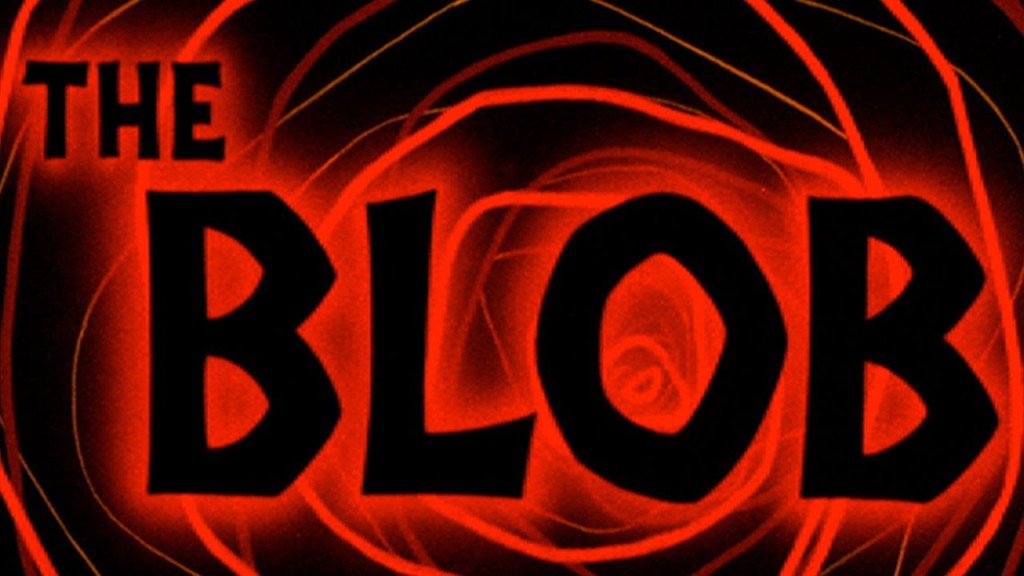“As Long as the Arctic is Cold”: The Blob
Appreciations // 1 Comment

One of the stories from my youth my Uncle Joe likes to tell is how we were watching The Blob. It must have been sometime in the first three years of my life since my mother and I still lived with my grandmother. The blob had eaten a dog, and my uncle said, “Isn’t that sad, the blob ate the little doggie?” I patted his arm and said, with the air of a burgeoning psychopath, “Don’t worry Uncle Joe, they can get another dog.” I was, of course, too young to remember this. And it may be that my uncle’s memory has altered it a bit. After all, in the original version of The Blob, there is a dog. But the dog lives. “I just saw it running down the street scared out of its wits,” one of the teens comments to Steve and his girlfriend Judy (Judy thought the dog had been eaten in the grocery store, and perhaps this was where my uncle told me the dog had been eaten).
In any case, The Blob was my intro to horror, and as such defies my ability to see it clearly. The plot is at once so ludicrous and genius, it’s no wonder the film despite poor acting, campy dialogue, and low budget special effects has become a classic. A meteorite falls to earth with a gelatinous organic substance that eats human flesh. As the substance consumes, it grows larger. It can’t be burned with fire, acid, or electricity. It can’t be shot. Seemingly, it can’t be killed and it scares little dogs out of their wits. What three year old wouldn’t love it? (My own daughter is this age now but can’t watch a movie if there’s even an argument in it. “Too scary,” she tells me whenever characters disagree. “It’s called drama,” I tell her. “It’s the basis of all storytelling,” but she’s not having it).
Nevertheless, I’m not three anymore and I still adore this movie. Yes, there’s a certain element of nostalgia both for my uncle’s anecdote and for the halcyon 1950s suburban setting. But there’s also a purity in the simplicity of storytelling I admire. It would be marvelous to remember how that three year old me felt about it. But all I can say is how I feel almost thirty-three years later watching it on a lazy Sunday morning while trying to give my son a bottle. I put it on precisely because it doesn’t take much effort to follow, because I can focus in at certain moments and let my attention lapse and still know what’s going on (a much smarter viewing choice than The Forgotten Plague the day before during this same attempt at feeding my son a bottle, the viewing of which made the experience all the more difficult because I was attempting to divide my attention). In the end, if it’s not a spoiler to reveal what happens at the climax of a film made almost 60 years ago, they freeze the blob with fire extinguishers and the army flies it to the arctic. “At least we got it stopped,” Lieutenant Dave, police chief, comments. “Yeah, as long as the arctic stays cold,” Steve responds. Did they foresee 60-some years ago the melting of the caps and decide to drop that question mark over the final scene? Obviously not, but it still comes off as prescient.
Of course, the 1950s gave rise to horror films built around the anxieties of the atom bomb and communism and The Blob can be read as either a mass extinction event or an omnipresent threat assimilating and absorbing individuals into one cohesive mass. But like the best of these films, Invasion of the Body Snatchers to name one, it works purely at the level of story. A couple teenagers know what’s going on and the adults don’t believe them. That’s part of its appeal as well. A gentle rebelliousness, as though the writers had seen Rebel Without a Cause and wanted to incorporate those elements, only without the melodrama and homoerotic subtext. In all, it’s a pretty tame movie, but it was my gateway to horror, so it’s always going to hold a special place in my heart. I’m also a sucker for technicolor.

Comments
Joe Jones
on April 7, 2016, 2:07 pm
The Blob stands as a 1950’s budget Sci-if story. No blood & guts here… even the bodies of it’s victims disappeared & just the hint of a struggle left behind. A mystery to be solved. To me a good way to spend your Saturday afternoon on a cold winters day, my nephew & a movie.